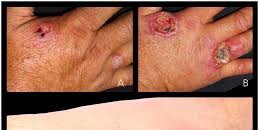
Fixed Drug Erruption
A fixed drug eruption is an allergic reaction to a medicine that characteristically recurs in the same site or sites each time a particular drug is taken.
It presents as well defined, round or oval patches of redness and swelling of the skin, sometimes surmounted by a blister. This then fades to a purplish or brown colour and the blister shrinks and peels off. In mucosal sites (lips, vulva, penis), extensive ulceration can occur.The hands and feet, lips, eyelids, genitalia and perianal areas are common sites.
Drugs that cause a fixed drug eruption
The number of drugs capable of causing fixed eruptions is large. Most reactions are due to the following medicines.
Paracetamol /phenacetin and other pain killers
Tetracycline antibiotics; doxycycline, minocycline
Sulphonamide antibiotics including trimethoprim + sulphamethoxazole, sulfasalazine
Acetylsalicylic acid/aspirin
Nonsteroidal anti-inflammatories (NSAIDs) including ibuprofen
Sedatives including barbiturates, benzodiazepines and chlordiazepoxide
Hyoscine butyl bromide
Dapsone
Phenolphthalein (an old-fashioned laxative for constipation)
Quinine
